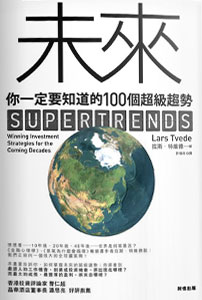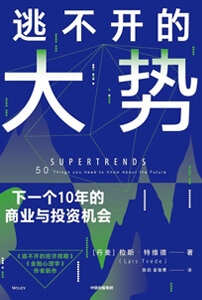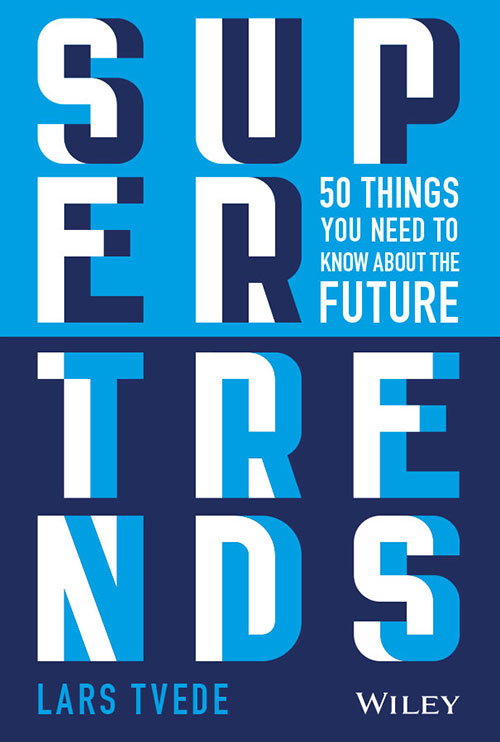TAKE A LOOK INTO THE FUTURE AND DISCOVER THE TRENDS THAT ARE SHAPING OUR WORLD IN 2019, I WROTE THE BOOK SUPERTRENDS ABOUT THE FUTURE, WHAT DRIVES IT AND HOW TO DEAL WITH IT. IN 2019, I WROTE A NEW VERSION OF THE BOOK BUT WITH A DIFFERENT PERSPECTIVE. SOME OF THE MAIN CONCLUSIONS FROM THESE BOOKS:
- There is no end to innovation.
Human scientific activity seems to double every 15 years and grow 100-fold every 100 years. It appears that this can continue as far as the eye can see, since computers will handle increasing parts of it at ever faster pace. Furthermore, since innovation is essentially about recombining what already exists, the more we have developed in the past, the more new things will be possible to create in the future. For these very reasons, innovation is, to all practical intents and purposes, endless and only limited by the extremely generous laws of physics plus the existence of liberal societies that permit free thinking. And whereas often, the first market response to new core technologies may seem disappointing, over time people figure out new business models and applications, which trigger endless cascades of new business opportunities and technologies. Infinitely. - On that note, we have lots of technologies with exponential or hyperexponential growth.
An increasing number of technologies exhibit exponential or hyperexponential growth. This includes, for instance, the sequencing and synthesising of DNA, global growth in the number of IoT devices, the amount of digital data produced and stored, the amount and speed of bandwidth available, the global OLED screen area output, the number of usable radio frequencies, the performance of LEDs, batteries, hard drives, etc. While I have provided numerous examples of these throughout the book, in reality, there are countless more. In particular, whenever a new technical field moves from analogue to digital, the rate of innovation and performance tends to move from linear to exponential, and more exponential phenomena pop up. By the way, there is a lot of this amazing progress that official calculations of GDP growth do not capture. - Among the most radical changes is the fact that we can now programme biology.
We very recently began to learn how to code life with great precision. With this technology we can eliminate existing species (specicide), make extinct species reappear (de-extinction), change species and create new ones en masse. And we can also re-code our own species, and there is no doubt we will. Increasingly, we will also code cells as if they are robots at our service so that they can perform magic for us. In short; we are the new programmers, and nature is our new computer. - AI and quantum computers will lead to recursive superintelligence.
In an increasing number of disciplines, computers beat the human mind, and increasingly this includes areas involving intuition. In this context, AI plays a huge role. Furthermore, quantum computers are on the verge of breaking through with powers to tackle certain kinds of calculations billions of times faster than the fastest supercomputers today – including, by the way, hacking a lot of standard encryption. All of this will have wide implications, but perhaps the biggest is that computers will become increasingly brilliant at formulating scientific hypothesis and writing software, and soon even better than any humans, which will stimulate run-away scientific discovery and technical innovation. - There will be sensors and Internet everywhere.
Far more than ever before, we will – through IoT – equip the non-organic part of the world with artificial nerve fibres, organs and small brains. So, a huge number of worldly objects will be able to do things that insects do – and will sometimes even look like them. In other words, we will create a completely non-biological ecosystem that will expand collective intelligence and capability, and unlike biological eco-systems, this one will be constantly analysed with big data and AI. This will certainly make the world as a whole smarter, but also less private. - We will never run out of resources.
The ultimate resource is innovation, and since this is not running out but rather evolving exponentially, the expectation that we will soon run out of resources will remain an unrealistic fear, as it has already been for centuries. Indeed, over the last 200 years, the real prices of all main categories of commodities have declined substantially and rather consistently. This happens because of innovative (1) synthetisation, (2) compression, (3) virtualisation, (4) recycling, (5) sharing and (6) substitution. Oddly, since our ultimate resource is innovation, the more people we are on Earth, the faster the rate of innovation – and the greater the abundance of resources per capita. In the future, this increased abundance will play out through, for example, the launch of new super-materials, smart genetic engineering, synthetic meat, vertical farming and new nuclear energy, including perhaps the use of thorium plus nuclear fusion. - Environmental problems will not be solved through light or dark environmentalism However, bright environmentalism (growth, wealth and innovation) will eventually do the jobs.
Experience tells us that the introduction of new and smarter technologies almost without exception resolve environmentally unsustainable practices, and that, overwhelmingly, these technologies are developed and first deployed in the richest of nations. Furthermore, the most efficient birth control is growing wealth. For this reason, we cannot solve environmental challenges by limiting growth, wealth or consumption. On the contrary. The way forward lies in more growth, wealth and innovation. Fortunately, a myriad of exceptional technologies to address environmental challenges are either rolling out or in the pipeline.
- Labour markets are turning Maslow’s Hierarchy of Needs upside down.
Increasingly, machines, robots and computers meet the demands described in the lower end of Maslow’s Hierarchy of Needs. Meanwhile, human labour increasingly make products and services that belong to the higher levels of the hierarchy – including theatre-like experience economy, assisted self-help, transcendental experiences and labour-of-love activities such as entrepreneurship, do-it-yourself and maker activity. - Digitalisation is not only about bits and bytes, but also about new granular markets and flexible lifestyles.
Digitalisation facilitates real-time dataflows, which again provide the information needed to break markets down into smaller tradeable units such as we see in crowdsourcing and the sharing economy. This includes granular markets for labour, data storage, software use, electricity and much more. Such granular units of products and services become available in clouds and at prices that fluctuate in real time. These markets are subject to ratings and transparent competition. This rating and cloud-based exchange of granular products and services, whether big, small or tiny, constitutes a significant refinement of our market economies and also one that counteracts inflation. Furthermore, when it comes to labour markets, these trends lead to the growth of a flexible gig economy, in which people increasingly have no fixed workplace, working hours, holidays or even pension age. Instead, they become more prone to live their adult lives in fluid combinations of work, leisure and learning – but perhaps never retiring. - The concept of money will radically change.
Money and other digital tokens and stores of value will increasingly become programmable so that they can be tied to specific situations such as purchase of specific kinds of goods under specific conditions only. Contracts will also increasingly become machine-readable and self-executing. - New technologies will stimulate new forms of organisation.
Just as mainstream computing migrated from a master-slave setup towards a client-server setup, followed by networked and edge computing, new technologies will drive leading management styles towards distributed, autonomous networked organisations, or what ex-McKinsey author Frederic Laloux has called ‘evolutionary organisations’. In this respect, the sharing economy and rating systems are vital and will continue to develop explosively. In other words, we are no longer talking only about smart objects, but also about smart ecosystems, in which both humans and machines will do business with each other in new, improved ways. However, in public management, the predominant management style will remain the hieratic conformist organisation for far too long, which will create tensions and problems. - We will gain access to more exciting experiences.
Some of them will come from new computer games and associated e-sports, new types of media and the likes of virtual and ambient computing: in other words, from electronics. We will also be offered fascinating new, physical, hybrid experiences that will enrich all of our senses and play on all our feelings, not to mention new combinations of physical and electronic experiences as in augmented reality. So much of this is going to be bloody amazing. - Along the way, all sorts of startling things will occur.
Some of these we can predict with a fair degree of certainty, others we can only conjecture about, while still others will materialise like a bolt out of the blue. Examples of the probable, which are now being worked on, are nuclear fusion, quantum computers, cultured meat, superintelligence, deexcitation, cancer vaccinations and radically life-prolonging technologies. But we must also expect the unexpected. For example, did you so much as envisage blockchain before it appeared? I doubt it. And how many people foresaw vaccines and anaesthesia before they arrived? Err… not many. - Future challenges will largely be met with future technologies.
Thanks to the staggering innovation of the future, we will inevitably discover that common assumptions that the challenges of the future will be solved with today’s technologies will often be wrong. For instance, in my opinion, it is obvious that within the next 100 years the world will have access to extreme amounts of comparably clean energy. But do I think that most of it will be generated by solar panels and wind turbines? Actually no. I think it will largely come from something that does not work today.
Covers and other Editions
This book has been published in international markets in several other languages and editions.





